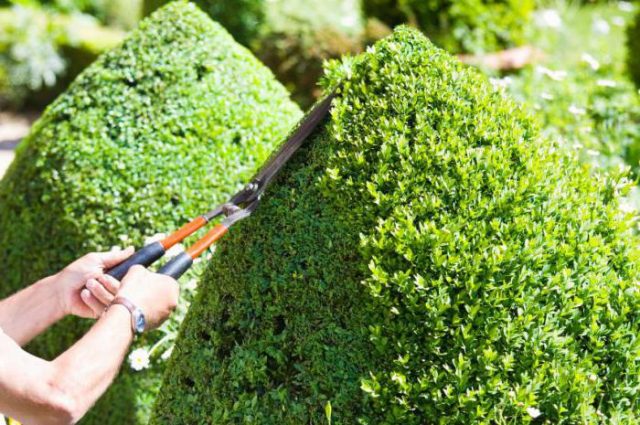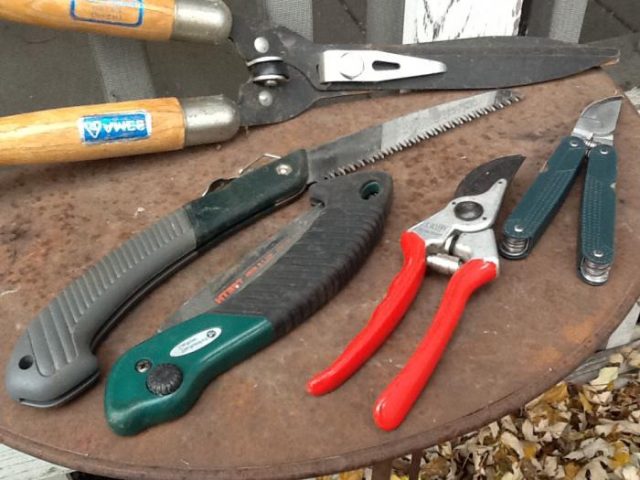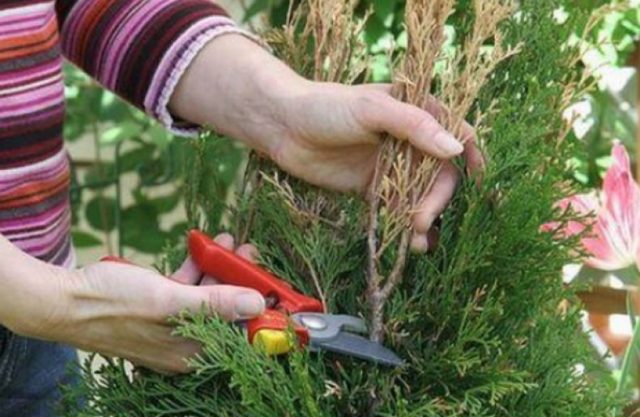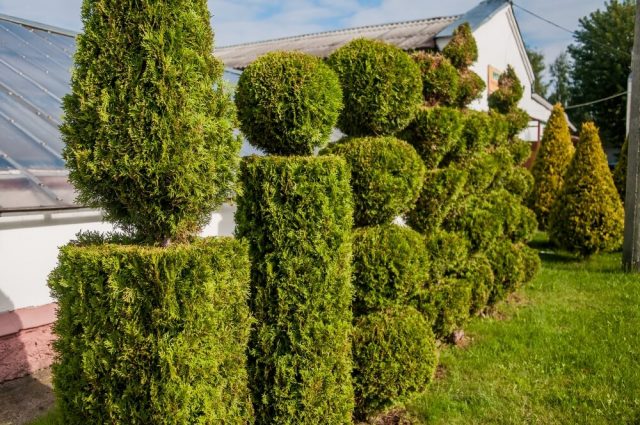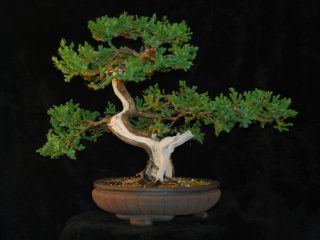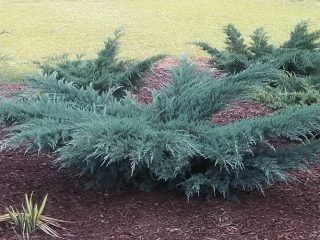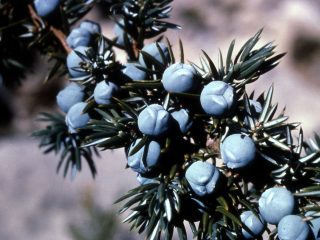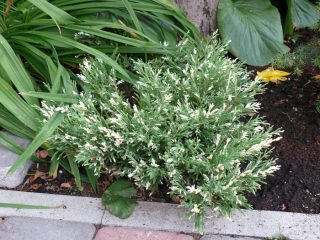Content
Juniper is often grown by lovers of ornamental garden and park plants. This evergreen coniferous shrub has many positive qualities. It is frost-hardy, unpretentious in care. Many treat its pruning as an optional procedure that does not give any positive effect, others are simply afraid of harming the health of the shrub. Meanwhile, it is possible and necessary to cut the juniper. This will not only improve the health of the bush, but also increase its decorative effect.
Is it possible to cut juniper
You can trim or trim junipers, but there are some rules to follow. If you carry out this procedure on time and do not get carried away too much, it will not cause any harm to the plant. On the contrary, many types of this shrub have a very flexible crown, which can be cut into various shapes, for example, geometric shapes, pillows or even hedges.
Below in the photo is a juniper haircut.
When and how to prune juniper
Juniper pruning can be done several times throughout the year. As a rule, it is made in the spring, in April-May, as well as in late summer or early autumn. It is not recommended to cut the juniper later, so as not to weaken it before wintering. Although most varieties of shrub have good frost resistance, pruning in the pre-winter period can severely damage it and lead to the death of individual shoots or even the entire plant. You should not prune junipers in the middle of summer, during the hottest season, and also in winter.
Choose a cool, cloudy day for pruning. On the eve of a haircut, it is advisable to spray the bushes with water. Of the tools you will need:
- secateurs;
- long-handled garden shears;
- hacksaw;
- lopper.
Tools must be sharp and clean, otherwise there is a risk of infection in open wounds. Before work, all cutting surfaces must be sharpened and disinfected. It should be remembered that a sharp tool leaves much smoother cuts that will tighten very quickly. Conversely, a wound with torn, uneven edges will get wet for a long time and can cause bush disease.
Be sure to use personal protective equipment such as gloves and overalls. Juniper resin is sticky and difficult to remove from clothing. It also contains toxic compounds that can irritate the skin or open wounds. Only common juniper is completely non-poisonous, pruning and caring for which is absolutely safe.
There are several types of juniper pruning. Each of them performs certain functions and is carried out according to the corresponding scheme. Cropping can be:
- sanitary;
- thinning out;
- formative.
Juniper trimming can be done in two ways.
- Point. This method of pruning involves removing part of the shoot and transferring its growth to a pre-selected bud. This is done at the initial stage, when the age of the juniper is still small, and the bush is just forming its permanent skeleton.
- Blind. This is a shearing with large garden shears, regardless of the location of the branches and buds. This method is used when the crown is fully formed and you just need to keep it in the required dimensions. The blind method is used when cutting hedges or bushes formed in the form of geometric shapes.
After finishing trimming, the entire tool must be cleaned and washed from the resin. You can use alcohol, organic solvents or detergents for this. After that, the instrument must be dried and disinfected again before using it again.
Sanitary pruning
Sanitary pruning of common juniper is carried out with the aim of improving the shrub, as well as for the prevention of diseases or stopping them at an early stage. Usually it is done twice a season. The first time the procedure is carried out in early spring, after the snow has melted. At the same time, broken and frozen branches are removed, which can be easily identified by a change in the color of the needles.
Re-examination for sanitary purposes is carried out in early autumn. Broken, dry, abnormally growing and diseased branches are cut at this time. Sanitary pruning sometimes has to be done forcedly, at the wrong time, for example, in the event of a disease or mechanical damage to the tree.
Thinning pruning
This type of pruning reduces the excessive density of the juniper crown, brightens the inner space of the bush. Can be carried out in the spring as well as at the end of summer. In the course of such pruning, the shoots growing inward are removed, the trunks are cleaned of small overgrowth, and the forks are eliminated, which in the future can cause the bush to break. Thinning the bush improves air exchange inside the crown, removes excess moisture, and this is important for the prevention of fungal diseases.
Formative pruning
Ornamental juniper varieties tend to grow rather quickly. Formative pruning limits their active growth and gives them a beautiful appearance. Basically, it consists in shortening the annual growth by about 20%, as well as cutting off shoots that go beyond the size of the formed crown. If the juniper is creeping, then it is formed into several large branches. All other shoots are completely cut out.
After the end of the haircut, the juniper needs care. To reduce the stress received by the plant, it is advisable to spray the bushes with a growth stimulant. This will promote the regeneration of damaged shoots and accelerate the rehabilitation process. But the sections remaining after the removal of large branches do not need to be covered with anything.
Features of cutting junipers of different types
Some types of juniper have a predisposition to crown formation in one way or another. Therefore, when choosing a variety for planting, it is advisable to know in advance where it will grow and in what form it will be formed. For example, the Chinese Blue Point or Kuriwao Gold can be used to shape the crown by trimming it into a ball, flattened sphere, or pillow. Rock juniper Wichita Blue is suitable for forming a cube-shaped crown, and Hibernica for a cylinder.
Some landscape designers choose not to prune the juniper, keeping the natural shape of its crown. This applies, first of all, to creeping varieties. However, even such species from time to time need to arrange a sanitary examination and remove damaged and diseased shoots. Columnar juniper varieties also need minimal intervention. They cut, as a rule, only the annual growth that goes beyond the lateral dimensions of the crown.
Juniper shaping tips
Pruning and shaping the crown of a juniper is quite an interesting, albeit time-consuming task. It is better to start forming decorative crowns from the simplest shapes - a cube, a rectangle. For convenience, you can use a rack or wire template. Only then, having gained the necessary experience and mastered the basic cutting techniques, you can start forming the crown of the bushes in the form of more complex geometric shapes, such as balls, cones, pillows. After a few years, you can learn to cut very complex shapes, for example, animal figures.
Here are some more tips to learn how to properly prune your juniper and avoid unnecessary mistakes when doing these jobs.
- The shoot growing upward is cut to the outer bud. If it grows down, then to the inside.
- All cuts are made at an angle of 45 °.
- When cutting a branch to a bud, you should always leave a 1.5-2 cm stump.
- All actions must be well calculated. Conifers are not very fast growing, so it will take several years to correct the error.
- It is always best to remove a little less than the excess.
- You can remove no more than 20% of the annual growth.
It should be remembered that the common juniper transferred from the forest, even with good care, takes root very poorly. In addition, in many regions, this plant in the wild is protected by law, since the populations of this shrub reproduce extremely slowly. Therefore, you need to take plants for planting in your personal plot only from the nursery. In suitable conditions, they take root well, and after a couple of years they can be formed in the right way.
Juniper haircut video:
Conclusion
Learning to cut a juniper correctly can be done pretty quickly if you do it all the time. The shrub tolerates this procedure well, it is only important not to overdo it and not to expose it to severe stress, removing a large number of shoots. A beautifully trimmed bush can become a real decoration, a kind of hallmark of the garden, and will delight both the owner and his guests for a long time.
